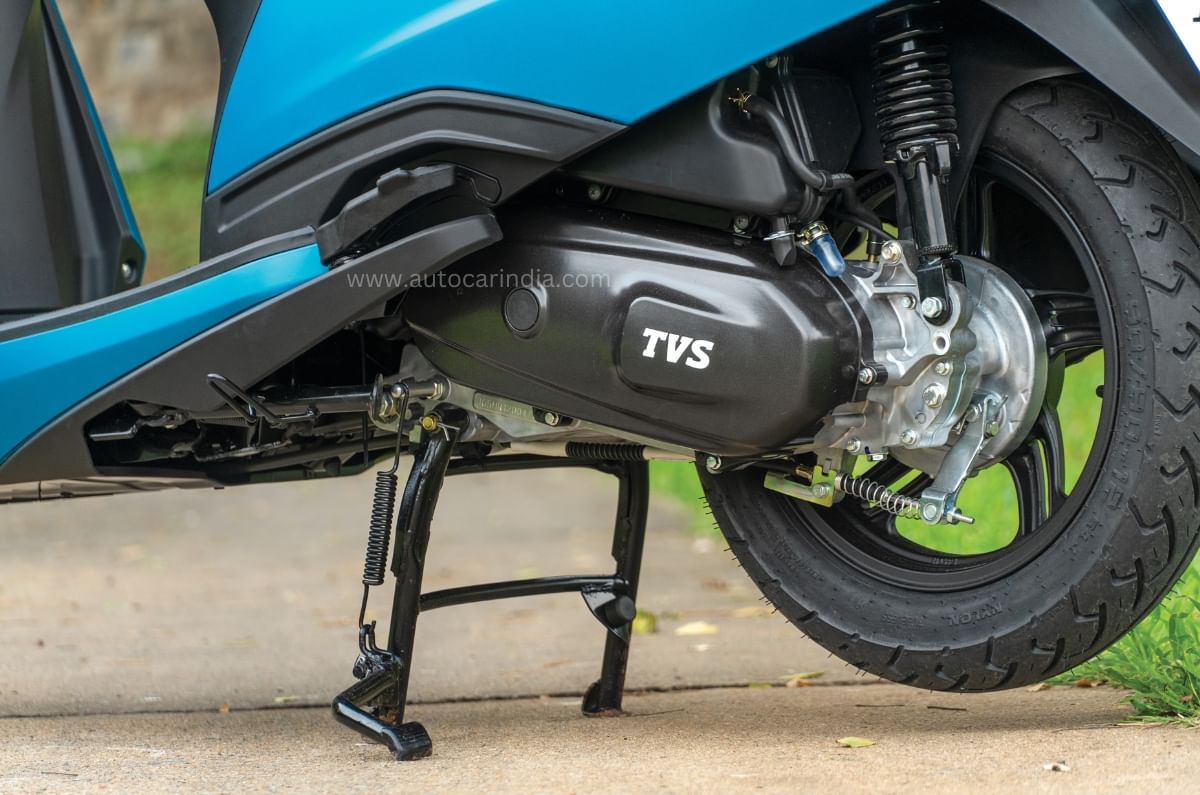2024 TVS Jupiter 110 review: Class Topper
TVS’ bestseller gets a complete overhaul with some nifty tech now.
Published on Aug 24, 2024 12:00:00 PM
32,982 Views
The Jupiter 110 is perhaps the most important two-wheeler for TVS, which explains why it has remained largely unchanged for the past eleven years. This is the second best-selling scooter in India, after a certain Honda, and that’s a commendable feat. However, unlike the Japanese company’s steadfast 'if it ain’t broke, don’t fix it' approach, TVS has completely reworked the Jupiter 110. The result is a brand-new model that now packs in some nifty tech and practical features borrowed from its elder sibling, the Jupiter 125.
TVS Jupiter 110 review: design, mechanical changes
The TVS Jupiter 110's design has taken a revolutionary route, at least for this category. While the earlier Jupiter's looks could be be perceived as a tad plain Jane, this 2024 update makes it decidedly sharper. The new, big LED DRL up front and the LED tail light (available only on the top variants) give it a much-needed identity of its own. In profile, the angular side panels remind you (slightly) of the sporty Ntorq.

You might have noticed that the scooter is missing a Kickstarter. TVS says the lower variants come standard with it, but you will need to shell out a little extra cheddar to add it as an accessory on the top variants. Make of that what you will, but I find it a tad curious.
The design spruce up is also backed by new mechanicals – the updated 113cc engine is a sleeved-down unit (smaller bore, same stroke) derived from the Jupiter 125. This motor is rated for a peak output of 8hp and 9.8Nm, which is a negligible 0.1hp increment but torque is up by 1 full Nm.
TVS Jupiter 110 review: new features
This increase in performance is due to the new 'iGO assist' micro-hybrid system that the Jupiter 110 now employs — a segment first, similar to what Yamaha is implementing in its 125cc scooters. This system comprises a more powerful battery, which is recharged by the engine during deceleration, allowing the ISG starter motor to give you a little extra pep on the move.
While TVS has upped the performance with the micro-hybrid system, the ISG motor also helps with more commonly seen features like a silent start and an engine start-stop function to aid fuel efficiency. The system shuts off the scooter if it remains idle for more than 5 seconds and restarts it when you twist the accelerator while holding the rear brake. The Jupiter’s start/stop tech isn’t the most seamless in operation, but is far from the worst.
TVS Jupiter 110 review: underseat storage
Like the Jupiter 125, the 110 also relocates the fuel tank (now 5.1 litres, down by 0.6 litres compared to the outgoing model) under the floorboard. The filler is positioned in front of the rider, at the back of the apron.
This design allows for a cavernous 33-litre boot, which can fit two half-face helmets, but an imported full-face helmet still won't fit. Additionally, there is a spacious 2-litre cubby below the key slot, which can comfortably accommodate a water bottle and a couple of large smartphones. A USB charging port is located just above this cubby.
The 2024 Jupiter comes with just a single luggage hook next to the cubby, unlike the outgoing model, which had two (the second one located just below the seat hinge). This is no big deal given how much more storage has been added under the seat, but it’s still worth noting.
TVS Jupiter 110 review: new technology
It's not that the outgoing Jupiter 110 wasn’t a feature-rich scooter, but TVS has upped the ante with the 2024 model. A new Bluetooth-compatible LCD dash is now available (lower models use an analogue cluster). Turn-by-turn navigation, call & notification alerts, real-time mileage, and distance to empty are shown, along with a voice assistant when paired with a Bluetooth headset. This brief first ride didn’t give us a chance to sample all of this, so stay tuned for a more detailed review soon.
TVS Jupiter 110 review: ride and handling
What we experienced was how the new Jupiter 110 handled TVS’ test track. With a couple of fast corners, a long straight, and a small patch of poorly paved surfaces, we could get a general idea of how the Jupiter will feel like in the real world.
Not that many Jupiter owners will try this, but since I take my job quite seriously (no, really), I did push it as much as I dared through the corners. Over a dozen laps around TVS’ track, the Jupiter felt stable and planted, no matter how much I turned up the wick. It is a little soft (which should make it ride well on the road) and is no Ntorq when it comes to handling, but it is confident and nimble, which is exactly what you want in a family scooter. The braking performance is reassuring too on the disc brake version that we rode and CBS helps reduce wheel lockup when applying the brakes hard in an emergency.
It’s difficult to give a definitive verdict on suspension comfort since we didn’t ride it on public roads. However, my gut (or rather, my back) tells me that it isn’t as softly sprung as the Suzuki Access. It's not a stiff setup in absolute terms, but is relatively firmer, which I suspect will make it more well-rounded and better suited for carrying a pillion or heavy loads. We’ll reserve final judgment until we can test it on Mumbai’s "roads," but this first impression has left me optimistic.
TVS Jupiter 110 review: price and verdict
In our brief time with the TVS Jupiter 110, it did very little wrong while clearly raising the bar over the already capable outgoing model. Moreover, among the few remaining rivals in the 110cc scooter category, none seem to balance features and riding dynamics as effectively as the 2024 Jupiter.
The Jupiter 110’s price starts at Rs 73,700 and goes up to Rs 87,250 (ex-showroom, Delhi), which is more or less on par with the outgoing version. However, there’s one caveat, since the front disc is only available on the top model, buying a Jupiter 125 with a front disc (Rs 84,000) is actually more affordable than the 110, which is perplexing.
Nonetheless, the TVS Jupiter 110 is on course to not only comfortably retain that number 2 position but also keep etching away at Honda's massive market share.
Also See:
Related Videos
Tech Specs
| Wheels and Tyres | Petrol |
|---|---|
| Front wheel (inch) | 12 inch |
| Front Tyre | 90/90-12 |
| Rear wheel (inch) | 12 inch |
| Rear Tyre | 90/90-12 |
| Feature Checklist | Petrol |
|---|---|
| Day-time Running Lights | Yes |
| Hazard Lights | Yes |
| USB port | Yes |
| Brake Lock | Yes |
| Luggage Hook | Yes |
| Under Seat Storage | 33 litres |
| Dimensions & Chassis | Petrol |
|---|---|
| Weight (kg) | 105 |
| Wheel base (mm) | 1275 |
| Ground Clearance (mm) | 163 |
| Seat height(mm) | 770 |
| Fuel Tank capacity (lts) | 5.1 |
| Price | Petrol |
|---|---|
| Price Range Ex-showroom - Delhi | Rs 73,700 - Rs 87,250 |
| Engine | Petrol |
|---|---|
| Cubic Capacity (cc) | 113.3 |
| Max Power (hp @ rpm) | 8hp at 6,500rpm |
| Max Torque (nm @ rpm) | 9.2Nm at 5,000rpm (without electric assist) / 9.8Nm at 5,000rpm (with electric assist) |
| Transmission | Petrol |
|---|---|
| Gearbox Type | CVT |
| Suspension | Petrol |
|---|---|
| Front Suspension | Telescopic fork |
| Rear Suspension | Monoshock |
Copyright (c) Autocar India. All rights reserved.


